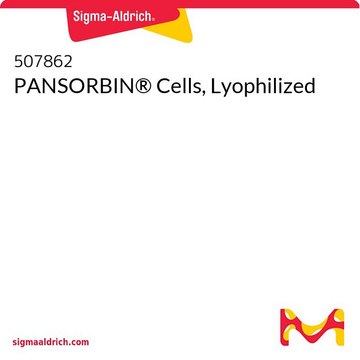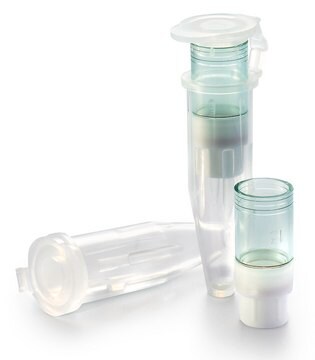507861
PANSORBIN® Cells, Standardized
Synonyme(s) :
Cell standard
Se connecterpour consulter vos tarifs contractuels et ceux de votre entreprise/organisme
About This Item
Code UNSPSC :
41116133
Nomenclature NACRES :
NA.42
Produits recommandés
Forme
liquid
Niveau de qualité
Contient
0.1% sodium azide as preservative
Fabricant/nom de marque
Calbiochem®
Conditions de stockage
do not freeze
Capacité
≥2 mg/mL binding capacity
Conditions d'expédition
ambient
Température de stockage
2-8°C
Description générale
Heat-killed, formalin-fixed Staphylococcus aureus cells (Cowan I strain) that bear a high cell-surface density of protein A and have been pickled by the method of Kessler. Useful as a solid-phase IgG-binding reagent due to the high-affinity interaction of protein A with the Fc domain of IgG. PANSORBIN cells work best when the antibody is human (IgG1, IgG2, IgG4), rabbit IgG (all isotypes), or mouse (IgG2a, IgG2b, IgG3).
PANSORBIN Cells are heat-killed, formalin fixed Staphylococcus aureus cells that have a coat of protein A and have been pickled by the method of Kessler. Useful for mitogenic stimulation of B lymphocytes and for immunoprecipitation.
Application
Most common applications include immunoprecipitation and mitogenic stimulation of B lymphocytes.
Avertissement
Toxicity: Standard Handling (A)
Forme physique
Supplied as a ≥10% (w/v) Staphylococcus aureus cell suspension in PBS, 0.1% sodium azide, pH 7.2.
Autres remarques
Kierszenbaum, F., et al. 1991. Immunology74, 317.
Meikle, P.J., et al. 1991. J. Biol. Chem.266, 22569.
Ezaki, O., et al. 1989. Biochem. Biophys. Res. Commun. 159, 1368.
Murakami, H., et al. 1988. Biochem. J.256, 917.
Kessler, S.W. 1975. J. Immunol. 115, 1617.
Meikle, P.J., et al. 1991. J. Biol. Chem.266, 22569.
Ezaki, O., et al. 1989. Biochem. Biophys. Res. Commun. 159, 1368.
Murakami, H., et al. 1988. Biochem. J.256, 917.
Kessler, S.W. 1975. J. Immunol. 115, 1617.
Informations légales
CALBIOCHEM is a registered trademark of Merck KGaA, Darmstadt, Germany
PANSORBIN is a registered trademark of Merck KGaA, Darmstadt, Germany
Mention d'avertissement
Warning
Mentions de danger
Conseils de prudence
Classification des risques
Acute Tox. 4 Oral
Code de la classe de stockage
12 - Non Combustible Liquids
Classe de danger pour l'eau (WGK)
WGK 3
Point d'éclair (°F)
Not applicable
Point d'éclair (°C)
Not applicable
Certificats d'analyse (COA)
Recherchez un Certificats d'analyse (COA) en saisissant le numéro de lot du produit. Les numéros de lot figurent sur l'étiquette du produit après les mots "Lot" ou "Batch".
Déjà en possession de ce produit ?
Retrouvez la documentation relative aux produits que vous avez récemment achetés dans la Bibliothèque de documents.
Menaka D Hapugoda et al.
Clinical and vaccine immunology : CVI, 14(11), 1505-1514 (2007-09-28)
The resurgence of dengue (DEN) virus infections in the last few decades coupled with the lack of a preventive vaccine and specific antiviral drugs has jointly contributed to making this a significant global public health problem. Currently, symptomatic supportive treatment
Use of recombinant vaccinia virus vectors for cell biology.
O A Weisz et al.
Methods in cell biology, 43 Pt A, 137-159 (1994-01-01)
Peifang Sun et al.
Methods in molecular biology (Clifton, N.J.), 1808, 187-196 (2018-06-30)
Dengue envelope (E) protein is a dominant antigen for vaccine development and E-based vaccines have shown partial or full protection against live-virus challenge in non-human primates. Generally, T cell responses can be investigated with peptides. However, hundreds of over-lapping peptides
K E Reed et al.
Methods in molecular medicine, 19, 331-342 (1999-01-01)
Heterologous expression systems have been widely used to study hepatitis C virus (HCV) proteins in lieu of an efficient method for establishing HCV infections in cell culture. Studies of HCV polyprotein processing in both mammalian-cell-based and cell-free expression systems have
Maria Forlenza et al.
Journal of immunology (Baltimore, Md. : 1950), 183(8), 5319-5332 (2009-09-30)
Functional characterization of TNF-alpha in species other than mammalian vertebrates is limited, and TNF-alpha has been studied in a limited number of fish species, primarily in vitro using recombinant proteins. Studies on TNF-alpha from different fish species so far pointed
Notre équipe de scientifiques dispose d'une expérience dans tous les secteurs de la recherche, notamment en sciences de la vie, science des matériaux, synthèse chimique, chromatographie, analyse et dans de nombreux autres domaines..
Contacter notre Service technique








